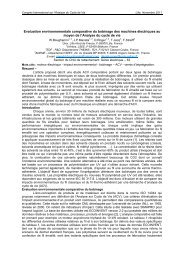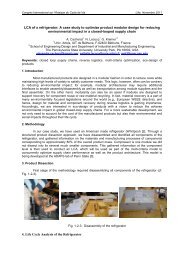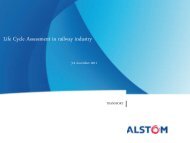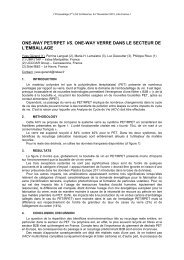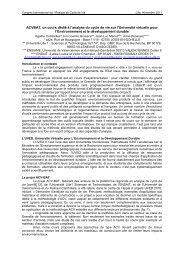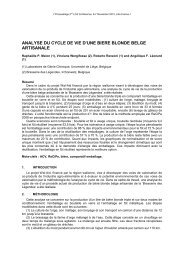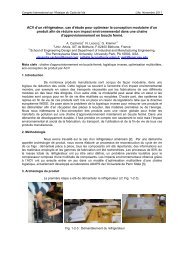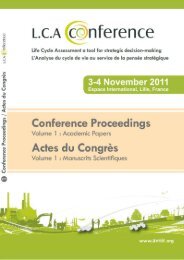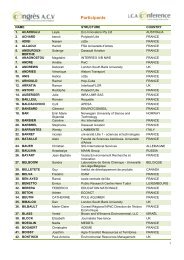Assessing Temporary Carbon Storage in Life Cycle Assessment and ...
Assessing Temporary Carbon Storage in Life Cycle Assessment and ...
Assessing Temporary Carbon Storage in Life Cycle Assessment and ...
You also want an ePaper? Increase the reach of your titles
YUMPU automatically turns print PDFs into web optimized ePapers that Google loves.
<strong>in</strong>stantaneous impacts. In LCA, some impact categories are covered by multiple <strong>in</strong>dicators at the<br />
midpo<strong>in</strong>t level (e.g. human toxicity uses both cancer <strong>and</strong> non-cancer effects). For <strong>in</strong>clud<strong>in</strong>g<br />
temperature <strong>in</strong>crease <strong>and</strong> rate of change, extensive work is still needed, although it would be promis<strong>in</strong>g<br />
<strong>and</strong> should be <strong>in</strong>vestigated further.<br />
2.3 Benefits of temporary carbon storage<br />
In his presentation (see Section 6.5), Marl<strong>and</strong> gave environmental <strong>and</strong> economic arguments <strong>in</strong> favour<br />
of temporary carbon storage: it buys time for technological progress <strong>and</strong> learn<strong>in</strong>g, it postpones climate<br />
change, some temporary sequestration may become permanent, sequester<strong>in</strong>g carbon keeps us on a<br />
lower carbon path <strong>and</strong> mediates the approach of tipp<strong>in</strong>g po<strong>in</strong>ts, etc. There is also an economic<br />
argument which states that temporary carbon storage has value as long as carbon emissions have a<br />
monetary value, whether this value is related to a cap-<strong>and</strong>-trade system, a carbon tax, or emission<br />
permits. An analogy was developed with the life <strong>in</strong>surance <strong>in</strong>dustry to show that the expected life time<br />
of temporary storage can be described <strong>in</strong> probabilistic terms, <strong>in</strong> order to give it a f<strong>in</strong>ancial value, which<br />
could be used to determ<strong>in</strong>e the cost of the temporary credits. Credits for permanent storage could be<br />
bought <strong>and</strong> sold, <strong>and</strong> credits for temporary storage could be rented.<br />
2.4 Do temporary carbon storage <strong>and</strong> delayed emissions matter?<br />
When assess<strong>in</strong>g temporary carbon storage, a time frame needs to be def<strong>in</strong>ed, s<strong>in</strong>ce there is no benefit<br />
for it on an <strong>in</strong>f<strong>in</strong>ite time basis. If the time frame is 100 years, stor<strong>in</strong>g carbon for a few years is<br />
important, but if the time frame is much longer, it becomes <strong>in</strong>significant. Kirschbaum presented three<br />
types of impact related to global warm<strong>in</strong>g: i) the <strong>in</strong>stantaneous temperature <strong>in</strong>crease, which leads to<br />
extreme weather conditions <strong>and</strong> diseases, ii) the rate of temperature <strong>in</strong>crease, which has an impact on<br />
ecological adaptation, <strong>and</strong> iii) cumulative heat<strong>in</strong>g or radiative forc<strong>in</strong>g, which impacts on long-term<br />
effects such as sea level rise. Stor<strong>in</strong>g carbon for a few years <strong>and</strong> releas<strong>in</strong>g it back to the atmosphere has<br />
two consequences: it decreases the cumulative heat<strong>in</strong>g of the atmosphere over a def<strong>in</strong>ed time frame,<br />
<strong>and</strong> it <strong>in</strong>creases the temperature at a given time <strong>in</strong> the short term. With a longer time horizon, both<br />
effects would become less significant. It is important to determ<strong>in</strong>e whether impacts occurr<strong>in</strong>g <strong>in</strong> the<br />
short-term are more important than those occurr<strong>in</strong>g <strong>in</strong> the long-term.<br />
The carbon cycle is dynamic. Tak<strong>in</strong>g carbon out of the atmosphere has consequences on the carbon<br />
flows elsewhere <strong>in</strong> the cycle, e.g. ocean uptake. Releas<strong>in</strong>g one tonne of carbon to the atmosphere or<br />
stor<strong>in</strong>g it for a period of time <strong>and</strong> releas<strong>in</strong>g it later would lead to different CO 2 concentrations at a<br />
given time <strong>in</strong> the future. It would lead to the same concentration for an <strong>in</strong>f<strong>in</strong>ite time frame, but the<br />
trajectories to that po<strong>in</strong>t there would be different, so the tim<strong>in</strong>g of the emissions matters with f<strong>in</strong>ite<br />
9



